
Protoceratops is a genus of sheep-sized herbivorous ceratopsian dinosaur, from the Upper Cretaceous Period of what is now Mongolia. It was a member of the Protoceratopsidae, a group of early horned dinosaurs. Unlike later ceratopsians, however, it was a much smaller creature that lacked well-developed horns and retained some primitive traits not seen in later genera.

Oviraptorosaurs are a group of feathered maniraptoran dinosaurs from the Cretaceous Period of what are now Asia and North America, though they have also been reported from the Eumeralla Formation of Australia and Lecho Formation in South America. They are distinct for their characteristically short, beaked, parrot-like skulls, with or without bony crests atop the head. They ranged in size from Caudipteryx, which was the size of a turkey, to the 8-metre-long, 1.4-ton Gigantoraptor. The group is close to the ancestry of birds. Analyses like those of Maryanska et al (2002) and Osmólska et al. (2004) suggest that they may represent primitive flightless birds. The most complete oviraptorosaur specimens have been found in Asia. The North American oviraptorosaur record is sparse.
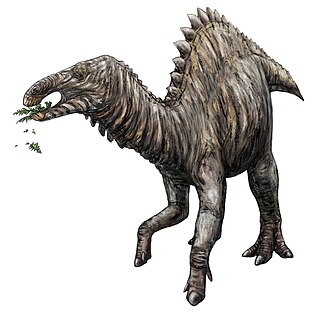
Tanius is a genus of hadrosauroid dinosaur. It lived in the Late Cretaceous of China. The type species, named and described in 1929 by Carl Wiman, is Tanius sinensis. The generic name honours the Chinese paleontologist Tan Xichou. The specific epithet refers to China. In 2010 Gregory S. Paul estimated the length of Tanius at seven metres and the weight at two tonnes.
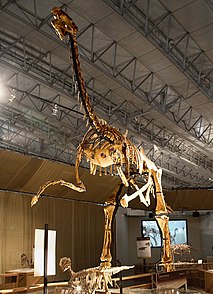
Gigantoraptor is a genus of giant oviraptorosaurian theropod dinosaur.

Dendroolithus is an oogenus of Dendroolithid dinosaur egg native to China and Mongolia. They can be up to 162 mm long and 130 mm wide. These eggs may have been laid by a Therizinosaur, Sauropod, or Ornithopod. The oospecies "D." shangtangensis was originally classified as Dendroolithus, however, it has since been moved to its own distinct oogenus, Similifaveoloolithus.. This oogenus is related with embryos of the theropod Torvosaurus
Dictyoolithus is an oogenus of dinosaur egg from the Cretaceous of China. It is notable for having over five superimposed layers of eggshell units. Possibly, it was laid by megalosauroid dinosaurs.
Shixingoolithus is an oogenus of dinosaur egg from the Cretaceous of Nanxiong, China.
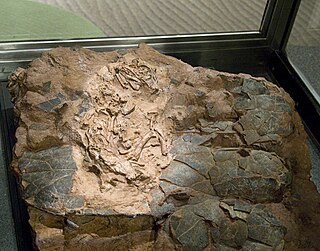
Macroelongatoolithus is an oogenus of large, fossil theropod eggs. They are known from Asia and from North America.

Macroolithus is an oogenus of dinosaur egg belonging to the oofamily Elongatoolithidae. The type oospecies, M. rugustus, was originally described under the now-defunct oogenus name Oolithes. Three other oospecies are known: M. yaotunensis, M. mutabilis, and M. lashuyuanensis. They are relatively large, elongated eggs with a two-layered eggshell. Their nests consist of large, concentric rings of paired eggs. There is evidence of blue-green pigmentation in its shell, which may have helped camouflage the nests.
Porituberoolithus is an oogenus of dinosaur egg found in the late Campanian of Alberta. It was originally described as distinct from the Elongatoolithids on the basis of its ornamentation, but it was listed as a member of that oofamily by Wang et al. 2010. It is very similar to Subtiliolithus, but has a thicker shell.
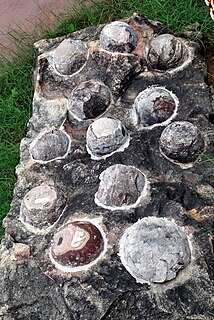
Egg fossils are the fossilized remains of eggs laid by ancient animals. As evidence of the physiological processes of an animal, egg fossils are considered a type of trace fossil. Under rare circumstances a fossil egg may preserve the remains of the once-developing embryo inside, in which case it also contains body fossils. A wide variety of different animal groups laid eggs that are now preserved in the fossil record beginning in the Paleozoic era. Examples include invertebrates like ammonoids as well as vertebrates like fishes, possible amphibians, and reptiles. The latter group includes the many dinosaur eggs that have been recovered from Mesozoic strata. Since the organism responsible for laying any given egg fossil is frequently unknown, scientists classify eggs using a parallel system of taxonomy separate from but modeled after the Linnaean system. This "parataxonomy" is called veterovata.

This timeline of oviraptorosaur research is a chronological listing of events in the history of paleontology focused on the oviraptorosaurs, a group of beaked, bird-like theropod dinosaurs. The early history of oviraptorosaur paleontology is characterized by taxonomic confusion due to the unusual characteristics of these dinosaurs. When initially described in 1924 Oviraptor itself was thought to be a member of the Ornithomimidae, popularly known as the "ostrich" dinosaurs, because both taxa share toothless beaks. Early caenagnathid oviraptorosaur discoveries like Caenagnathus itself were also incorrectly classified at the time, having been misidentified as birds.
Stalicoolithus is an oogenus of dinosaur egg from the Tiantai Basin in Zhejiang Province. It is known from a single, complete fossil egg, notable for its spherical shape.
Coralloidoolithus is an oogenus of dinosaur egg from the Tiantai Basin in Zhejiang Province, containing a single known oospecies C. shizuiwanensis. Formerly, it was classified in the oogenus Paraspheroolithus; however, it was considered sufficiently different to be classified in its own genus. C. shizuiwanensis is similar to Stalicoolithus, leading to their classification in the same family, Stalicoolithidae.
Similifaveoloolithus is an oogenus of fossil dinosaur egg from the Tiantai basin in Zhejiang Province, China. It is the sole known oospecies of the oofamily Similifaveoloolithidae.
Hemifaveoloolithus is an oogenus of fossil dinosaur egg from the Tiantai basin in Zhejiang Province, China. It is a faveoloolithid, having spherical eggs roughly 13 cm in diameter. The shell is distinctive for being composed of four or five superimposed layers of shell units, and the honeycomb-like arrangement of pore canals.
Undulatoolithus is an oogenus of Chinese fossil dinosaur egg belonging to Elongatoolithidae. It is very similar to Macroolithus, but has different ornamentation. Like other elongatoolithids, it was probably laid by oviraptorosaurs.
Dictyoolithidae is an oofamily of dinosaur eggs which have a distinctive reticulate organization of their eggshell units. They are so far known only from Cretaceous formations in China.
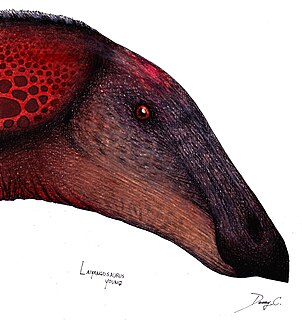
Laiyangosaurus is a genus of saurolophine hadrosaurid from the Late Cretaceous of China. It is known from one species, L.youngi, found in the Laiyang Basin within the province of Shandong.
"Tanius" laiyangensis is a dubious species of kritosaurin hadrosaur from the Late Cretaceous Wangshi Group of Shandong, China. It was originally described in 1976 as the third species in the genus Tanius, based on a sacrum and partial ilium. The type species of the genus, Tanius sinensis, was later found to be a basal hadrosauroid as opposed to be a member of Hadrosauridae. T. laiyangensis was, after its description, variously considered a nomen dubium or a synonym of the lambeosaur Tsintaosaurus. In 2019, T. laiyangensis was re-evaluated, and found to be an indeterminate kritosaur, unrelated to the true Tanius. Material from the same formation, initially referred to the edmontosaur Laiyangosaurus, was also identified as being from a kritosaur, and so possibly belonged to the same species. It is the first recognized kritosaur to be found in Asia, and its closest relative was found to be Secernosaurus from Argentina.









